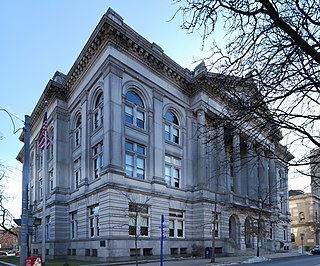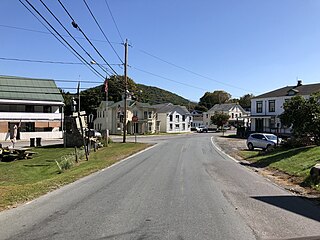
Rensselaer County is a county in the U.S. state of New York. As of the 2020 census, the population was 161,130. Its county seat is Troy. The county is named in honor of the family of Kiliaen van Rensselaer, the original Dutch owner of the land in the area. The county is part of the Capital District region of the state.

Berlin is a town in Rensselaer County, New York, United States. The population was 1,808 at the 2020 census. The town is named after Berlin in Germany, although natives pronounce the name differently, with the accent on the first syllable.

Brunswick is a town in Rensselaer County, New York, United States. The municipality was originally settled in the early 18th century. During its history, it had been part of Albany County, Rensselaerswyck, and Troy, before its incorporation in 1807. It is bordered on the west by the city of Troy; on the north by Schaghticoke and Pittstown; on the east by Grafton; and on the south by Poestenkill and North Greenbush. The population was 12,581 at the 2020 census. The source of the town's name is not certain, though some claim it comes from the source of its first inhabitants from the province of Brunswick-Lüneburg in Germany.

Grafton is a town in Rensselaer County, New York, United States. The population was 2,051 at the 2020 census. It is believed that the town received its name from Grafton, Vermont, where the first town supervisor, Nathaniel Dumbleton, was originally from. The town is an interior town near the north-central part of the county. NY Route 2 passes across the town.

Sand Lake is a town in south-central part of Rensselaer County, New York, United States. Sand Lake is about 13 miles east of Albany, New York. As of the 2020 census, the population was 8,348. Within the town are three hamlets: Averill Park, Glass Lake and the hamlet of Sand Lake. Its four lakes are a source of recreation. Many commercial enterprises of the 19th century and into the 20th century relied on power generated from the Wynants Kill Creek and Burden Lake mills. The area is known for its fertile soil for grazing and agriculture.

Troy is a city in the United States state of New York and is the county seat of Rensselaer County, New York. It is located on the western edge of that county on the eastern bank of the Hudson River just northeast of the capital city of Albany. Troy has close ties to Albany, New York and nearby Schenectady, forming a region popularly called the Capital District.

East Greenbush is a town in Rensselaer County, New York, United States. It is a suburb of Albany. The population was 16,748 at the 2020 census. The word Greenbush is derived from the Dutch het groen bosch, referring to the pine woods that originally covered the land. The first settlement of the land now known as East Greenbush was made by tenants under patroon Kiliaen van Rensselaer circa 1630. The town was established in 1855 as Clinton, and was renamed in 1858. It is mostly suburban along its major highways and rural in the southwestern and northeastern corners.

Poestenkill is a town in Rensselaer County, New York, United States. The population was 4,322 at the 2020 census. The town is southeast of Troy and is centrally located in the county.
A kill is a body of water, most commonly a creek, but also a tidal inlet, river, strait, or arm of the sea. The term is derived from the Middle Dutch kille, meaning "riverbed" or "water channel". It is found in areas of Dutch influence in the Netherlands' former North American colony of New Netherland, primarily the Hudson and Delaware Valleys.

Kiliaen van Rensselaer was a Dutch diamond and pearl merchant from Amsterdam who was one of the founders and directors of the Dutch West India Company, being instrumental in the establishment of New Netherland.

The Sacandaga River is a 64-mile-long (103 km) river in the northern part of New York in the United States. Its name comes from the Native American Sa-chen-da'-ga, meaning "overflowed lands".

Rensselaerswyck was a Dutch colonial patroonship and later an English manor owned by the van Rensselaer family located in the present-day Capital District of New York in the United States.
Van Rensselaer Island was an island in the Hudson River opposite the city of Albany, New York. The island was also known as de Laet's Island, Kalebacker's Island, Boston Island and B&A Island, the last two names in reference to the Boston and Albany Railroad. The island stretched from Mill Creek north to the Livingston Avenue Bridge. Van Rensselaer Island is now connected to the City of Rensselaer, and is no longer an island.

The Map of Rensselaerswyck[a] is a map created during the 1630s, probably 1632, at the request of the owner of the Manor of Rensselaerswyck, Kiliaen van Rensselaer, Dutch jeweler and patroon. Rensselaerswyck was the only successful patroonship within the colony of New Netherland, settled by the Dutch West India Company at the behest of the States-General of the United Netherlands. The map is believed to be the first ever commissioned or created of Rensselaerswyck.

The history of Troy, New York extends back to the Mohican Indians. Troy is a city on the east bank of the Hudson River about 5 miles (8.0 km) north of Albany in the US State of New York.
Mill Creek, also previously known as Tierken Kill, is a tributary to the Hudson River. Poetanock was the Native American name for the stream. From its source just west of Snyders Lake in East Greenbush the stream travels southwest, then north and west to the Hudson River. The stream has two waterfalls on the Mill Brook: the Upper Falls, and the Lower Falls. The mouth of the creek is on the Hudson River opposite from Albany, New York at what was Van Rensselaer Island, in the City of Rensselaer.
The Wynants Kill is a 15.8-mile-long (25.4 km) stream which has its source at Glass Lake near Averill Park, New York, and terminates at the Hudson River at Troy, New York.

Sparkill Creek, is a tributary of the Hudson River in Rockland County, New York and Bergen County, New Jersey in the United States. It flows through the Sparkill Gap in the Hudson Palisades, which was created by a fault line which provided the only sea-level break in the Palisades.
Dyken Pond is a 134-acre (54 ha) lake in the towns of Grafton and Berlin in Rensselaer County, New York. The pond gets water primarily from precipitation and outflows westward into the Poesten Kill, a tributary of the Hudson River. It is located in northwest Berlin, south of Grafton Lakes State Park.

The Barberville Falls is a waterfall and nature preserve located in Poestenkill, New York. The fall flows into the Poesten Kill, which is a large creek that flows through Rensselaer County.



















